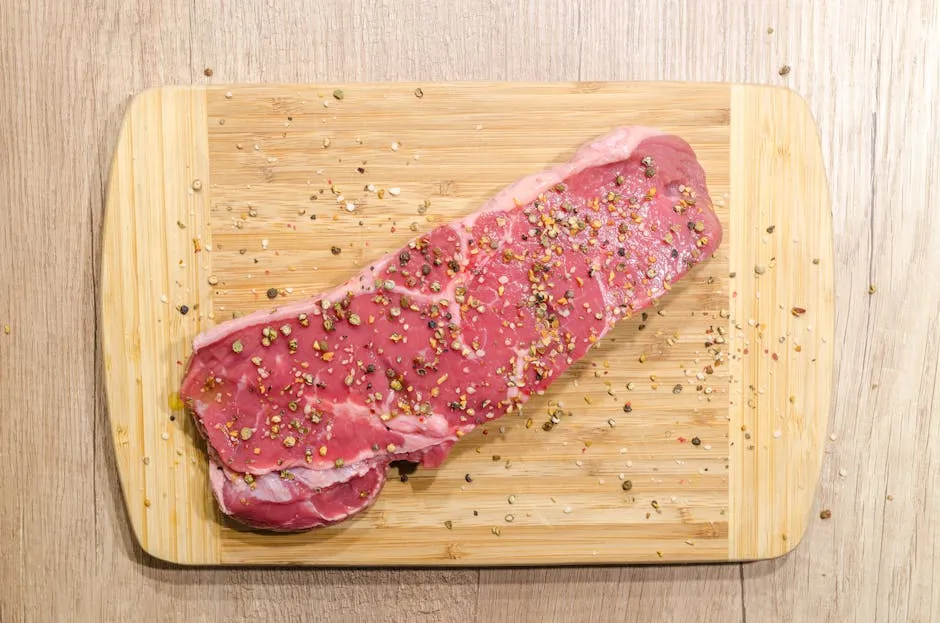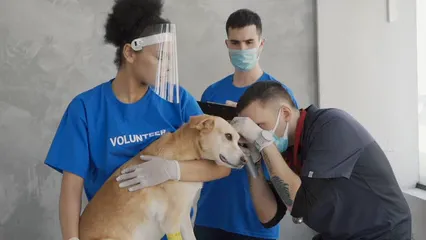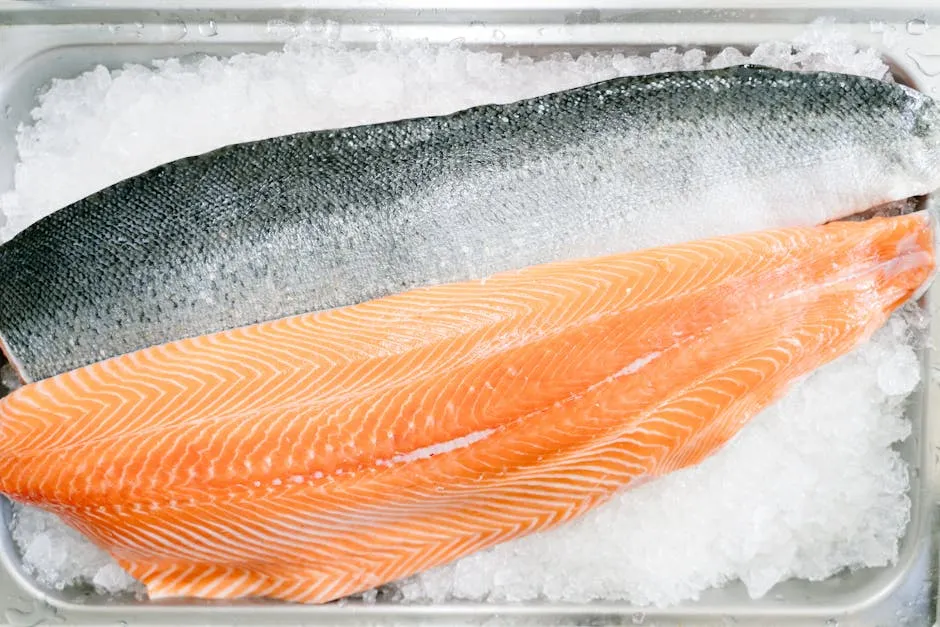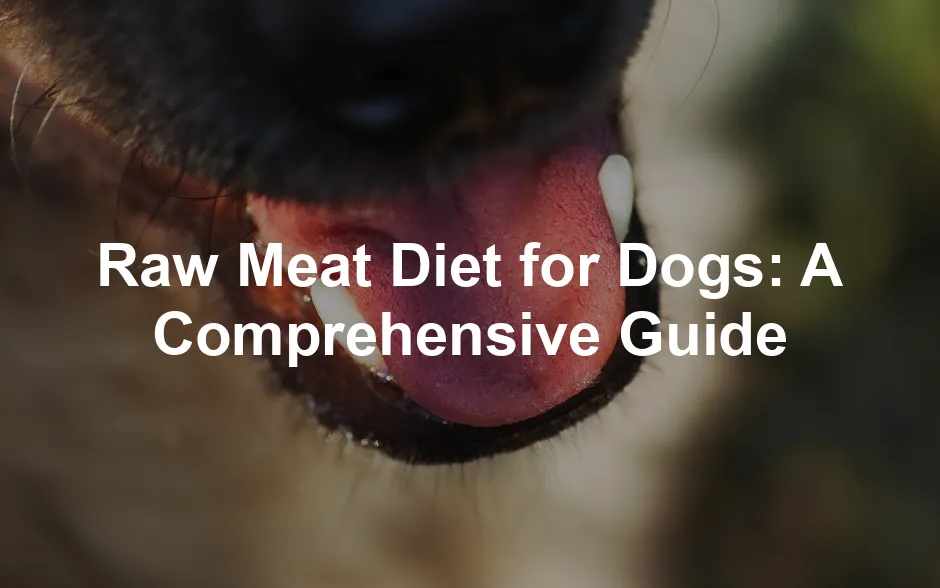Introduction
Raw meat diets for dogs are becoming more popular. Many pet owners believe these diets offer health benefits. However, the topic is controversial, sparking debate among veterinarians and nutritionists. This article aims to look deeper into the benefits, risks, and best practices for raw meat diets for dogs.
Summary and Overview
A raw meat diet typically includes raw meat, bones, organs, and sometimes vegetables. This approach mirrors the natural eating habits of dogs’ wild ancestors. The BARF diet, which stands for Biologically Appropriate Raw Food, popularized this concept in the 1990s. However, opinions vary. Proponents argue for its benefits, such as improved skin and coat health. Critics raise concerns about nutritional imbalances and safety risks. Consulting with a veterinarian is crucial before changing your dog’s diet to ensure it meets their specific needs. For a comprehensive understanding of the BARF diet, check out this BARF diet for dogs.
To kickstart your journey into raw feeding, consider investing in Raw Dog Food options that cater to your dog’s dietary needs. Your furry friend will thank you with every wag of their tail!
Understanding the BARF diet is essential for any dog owner considering raw feeding. Learn more about the BARF diet here.
Understanding Raw Meat Diets for Dogs
What is a Raw Dog Food Diet?
A raw dog food diet consists of several key components: raw meat, bones, and organs, along with optional fruits and vegetables. Muscle meat provides protein, while bones supply calcium. Organs like liver offer essential vitamins. The BARF model recommends a mix of these ingredients to meet a dog’s nutritional needs. In contrast, RMBD (Raw Meat-Based Diet) focuses solely on animal products, excluding plant-based ingredients. Statistics indicate that about 15% to 25% of dog owners now feed raw diets. This trend reflects a growing interest in biologically appropriate diets for canines. It’s essential to research raw feeding thoroughly before making any decisions.
If you’re looking for a great way to store your raw dog food safely, consider a Pet Food Storage Container. This will keep your dog food fresh and safe from pesky critters while ensuring your kitchen remains organized. Because nobody wants a raccoon crashing their dinner party!

Benefits of a Raw Meat Diet for Dogs
Potential Health Benefits
Switching to a raw meat diet can offer several benefits for dogs. Many pet owners report improvements in their dogs’ coat condition. A shinier, healthier coat often results from the higher fat content in raw meat. Dogs may also experience better skin health, reducing dryness and irritation.
Dental health is another area where raw feeding shines. Chewing on raw meaty bones helps remove plaque and tartar, leading to cleaner teeth and fresher breath. This natural dental care can save on vet bills for dental cleanings. Consider investing in Raw Meaty Bones to enhance your dog’s dental routine and keep their smiles bright!
Energy levels can also see a boost. Many owners notice their pets are more active and playful after switching to raw diets. This increase in energy may stem from the high protein content found in raw meat, which aligns with a dog’s natural dietary needs.
According to a study published in the Journal of Animal Science, raw-fed dogs showed improved overall health markers, including better digestion. The report emphasized that many raw-fed dogs produced smaller stools, indicating efficient digestion.
However, before making any changes, consult your veterinarian for tailored dietary plans that suit your dog’s unique needs. Don’t forget to supplement their diet with Dog Multivitamins to ensure they’re getting all the nutrients they need!

Risks and Concerns of Raw Meat Diets
Potential Health Risks
While a raw meat diet offers benefits, it also carries risks. One major concern is bacterial contamination. Raw meat can harbor harmful bacteria, such as Salmonella and E. coli. These pathogens pose health risks not only to dogs but also to humans handling the food.
Nutritional balance is another potential issue. It can be challenging to provide a complete diet with all necessary vitamins and minerals when feeding raw. A poorly balanced diet may lead to deficiencies over time, affecting your dog’s health.
Choking hazards are also a concern, particularly from bones. While raw bones can aid dental health, they may splinter and cause blockages or internal injuries. Monitoring your dog while they chew bones is essential to avoid emergencies. To prevent any accidents, consider a Dog Nail Clippers for regular grooming, ensuring their nails are always in check!
According to the CDC, there have been numerous incidents linked to raw feeding, underscoring the importance of safe food handling. Prioritize hygiene when preparing and feeding raw meat. Always consult a veterinarian to address any concerns and ensure you’re meeting your dog’s nutritional needs.

Transitioning to a Raw Meat Diet
Steps to Safely Transition Your Dog
Transitioning your dog to a raw meat diet requires care. Start by mixing a small amount of raw food with their current diet. Gradually increase the raw portion over ten days.
For the first three days, offer 25% raw and 75% of their old food. Next, switch to a 50/50 mix for another three days. Finally, serve 75% raw and 25% old food for the last four days.
This gradual change helps prevent digestive issues. Monitor your dog’s stool and overall health throughout the process. If you notice any concerns, consult your veterinarian. Tracking your dog’s health during this transition ensures they adapt well to their new diet. A handy Dog Food Scoop can help you measure portions accurately!

Choosing the Right Raw Dog Food
Selecting Quality Ingredients
Choosing the right ingredients is crucial for a raw diet. Look for high-quality raw meat products that are safe and nutritious. Always source from reputable suppliers to ensure the meat is fresh and free from harmful pathogens.
According to recent statistics, commercially prepared raw food options have increased significantly. These products often meet safety standards, making them convenient for busy pet owners. For an effortless feeding experience, consider a Dog Bowl (Stainless Steel) that is both durable and easy to clean!
When selecting raw food, consider the nutritional adequacy of the ingredients. Opt for products that provide a balanced diet for your dog. This approach reduces the risk of deficiencies and helps maintain their health.

Expert Opinions on Raw Feeding
When it comes to raw feeding, veterinarians hold diverse views. Some believe raw diets can enhance a dog’s health. They often cite benefits like improved skin, coat, and dental hygiene. Others, however, express caution. They highlight concerns over nutritional balance and safety risks. It’s vital to remember that no single diet suits every dog.
Personalized dietary advice from a veterinarian is crucial. Your vet understands your dog’s unique health needs. They can help you navigate raw feeding safely. Whether you’re considering a raw diet or have questions about it, professional guidance is key. Always consult your vet before making significant changes to your dog’s diet. Your furry friend deserves the best care possible. Don’t forget to have a Dog Health Book handy for reference!

Conclusion
In this article, we explored the raw meat diet for dogs. We discussed its potential benefits, such as healthier coats and improved energy. However, we also highlighted risks like bacterial contamination and nutritional deficiencies. A balanced approach is essential for your dog’s well-being.
Always prioritize responsible feeding practices. Regular consultations with your veterinarian can help ensure your dog’s diet meets their needs. If you’re considering raw feeding, do so with care and guidance. Your dog’s health and happiness depend on it! To keep your dog hydrated and happy, consider a Pet Water Fountain that encourages them to drink more water!
FAQs
Is raw meat safe for dogs?
Feeding raw meat to dogs can be safe, but caution is essential. Proper handling and hygiene are crucial to avoid bacterial contamination. Always wash hands and surfaces after preparation. Consult your veterinarian for guidance on safe practices and suitable meat sources.
What are the benefits of a raw meat diet for dogs?
A raw meat diet may lead to several benefits. Many owners report shinier coats, improved skin health, and fresher breath. Dogs often experience higher energy levels and better digestion. Additionally, raw diets can help maintain healthy teeth by reducing plaque buildup.
How do I transition my dog to a raw diet?
Transitioning should be gradual. Start by mixing a small amount of raw food with your dog’s current diet. Over about ten days, slowly increase the raw portion while decreasing their old food. Monitor your dog’s response to ensure a smooth adjustment.
Can puppies eat raw food?
Yes, puppies can eat raw food, but special care is needed. Their diets must be well-balanced to support growth. Consult a veterinarian for specific recommendations tailored to your puppy’s age and nutritional needs.
What should I include in my dog’s raw diet?
A balanced raw diet should include muscle meat, bones, and organs. Aim for a mix of protein sources like chicken, beef, and fish. Adding some fruits and vegetables can enhance nutrition, but it’s essential to monitor for allergies or sensitivities.
How can I ensure my dog’s raw diet is nutritionally complete?
To achieve a balanced diet, consult a veterinarian or pet nutritionist. They can help you design a meal plan that meets all nutritional needs. Consider using commercially prepared raw diets that follow guidelines for completeness.
What precautions should I take when feeding raw meat?
Maintain strict hygiene practices. Use separate utensils and dishes for raw food. Always wash hands before and after handling raw meat. Store raw ingredients safely and avoid cross-contamination to protect both your dog and your family.
Please let us know what you think about our content by leaving a comment down below!
Thank you for reading till here 🙂
All images from Pexels





